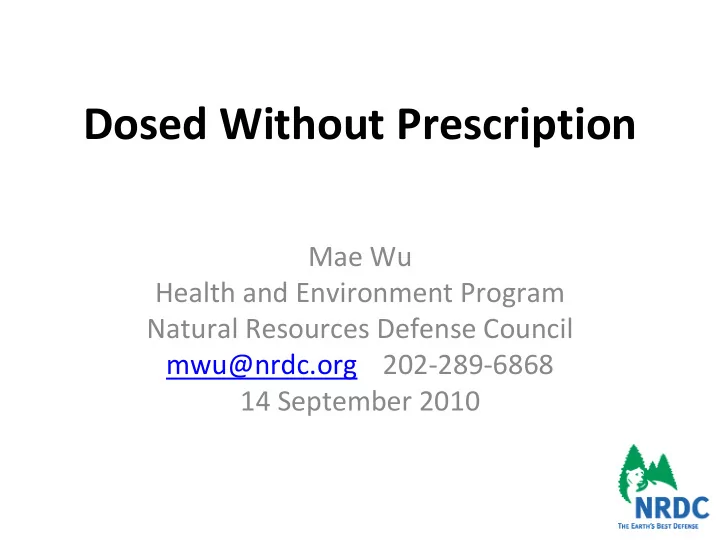

Dosed Without Prescription Mae Wu Health and Environment Program Natural Resources Defense Council mwu@nrdc.org 202 ‐ 289 ‐ 6868 14 September 2010
Pipeline • Design • Approval FDA – FFDCA, NEPA • Production EPA – Clean Water Act (NPDES), Clean Air Act (ESHAPs), Safe Drinking Water Act (CCL, UCMR) • Use FDA EPA – RCRA • Disposal/Discharge DEA – Controlled Substances Act
Use • Physician Behavior – Over ‐ prescription – Influence behavior through classification (Swedish example) • Marketing • Off ‐ label Use • Prescription Plans – E.g. 90 ‐ day, 30 ‐ day prescriptions
Disposal/Discharge • Intentional Disposal – EPA Guidance Document: Best Management Practices for Unused Pharmaceuticals at Health Care Facilities • Unintentional Disposal – Human – Animal (CAFOs) • Incineration • Wastewater Treatment
Unanswered Questions What is the volume of pharmaceuticals in our tap water and in our waterways? • Can these amounts cause or contribute to adverse human health effects, • considering sensitive populations and their presence as a complex mixture in drinking water? Is there a pharmaceutical class or category of biggest concern? • What proportion of pharmaceutical contaminants come from excretion from • humans versus disposal down the toilet? What is the relative contribution from animal uses, especially concentrated • animal feeding operations for antibiotic and growth hormone drugs? Is the disposal in landfills a significant source of contamination? What is the • best disposal method to protect the environment? How persistent are pharmaceuticals in the environment and how effective is • conventional wastewater treatment and drinking water treatment in destroying them? What is the magnitude of waste per unit of desired product coming from • manufacturing pharmaceuticals and how much of this waste is active ingredient, hazardous chemicals, or biological hazardous waste?
Recommend
More recommend